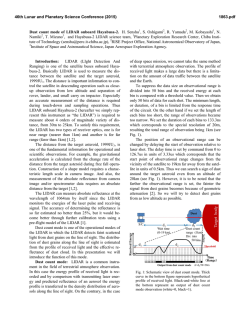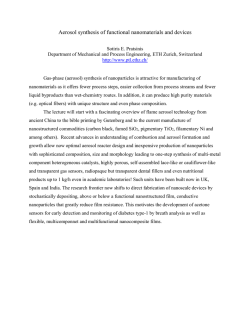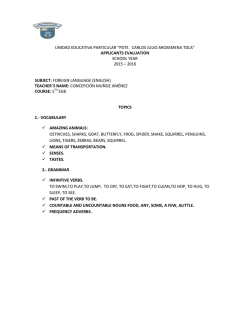
Optical measurements of atmospheric by CMAX-DOAS and
Universidad de Concepción Optical measurements of atmospheric properties by CMAX-DOAS and LIDAR at Concepcion, Chile Rodrigo Fuentes-Inzunza ( 1 ) , * , E. Montilla-Rosero ( 1 ) , A. Silva ( 1 ) , ( 4 ) , C. Jiménez , ( 3 ) , Rolando Hernández 1 , 2 and Carlos Saavedra 1 , 2 1 Center for Optics and Photonics, Universidad de Concepción, Casilla 4016, Concepción, Chile. 2 Departamento de Física, Universidad de Concepción, Casilla 160-C, Concepción, Chile. 3 Now at, Leipzig, Germany. 4 Now at Universidad de la Frontera, Temuco, Chile. * email: [email protected] VIII Workshop LIDAR Measurements in Latin America / Tryp Cayo Coco / CUBA / 6 to /April / 2015 Outline 1.- Instrumentations: CEFOP (UdeC) LALINET station - Sunphotometer AERONET - LIDAR System - DOAS System 2.- CMAX-DOAS Instrument and AMIS acquisition - Instrument Capabilities. - The Optical Head and Tripod. - The Fiber Optics: Five Track Fiber Bundle. - The Atmospheric Monitoring Image Spectrometer (AMIS) 3.- Retrieval Aerosol Properties from oxygen dimer O4 Absorption - Molecular identification of trace gases. - Aerosol optical properties. VIII Workshop LIDAR Measurements in Latin America / Tryp Cayo Coco / CUBA / 6 to /April / 2015 36.82 S, 73.05 W, 170 m. Pacific Ocean Concepción UdeC LIDAR-CEFOP Bio Bio River 1.- Instrumentations: CEFOP (UdeC) ALINET station Emphasis on tropospheric aerosols, water vapor mixing ratio in lower troposphere, trace gases, radiative transference calculation. Sunphotometer AERONET VIII Workshop LIDAR Measurements in Latin America / Tryp Cayo Coco / CUBA / 6 to /April / 2015 Instrumentations: Emphasis on tropospheric aerosols, water vapor mixing ratio in lower troposphere, trace gases, RTC. LIDAR System Elastic LIDAR 532, 355nm Raman LIDAR 387, 407nm VIII Workshop LIDAR Measurements in Latin America / Tryp Cayo Coco / CUBA / 6 to /April / 2015 Instrumentations: Emphasis on tropospheric aerosols, water vapor mixing ratio in lower troposphere, trace gases, RTC. DOAS System Multiple Telescopes 3, 5, 10, 15 y 90 degree VIII Workshop LIDAR Measurements in Latin America / Tryp Cayo Coco / CUBA / 6 to /April / 2015 2.- LIDAR – CEFOP System: Polychromator Actually: Elastic 532, 355 nm Raman 387nm N2, 407nm H2O VIII Workshop LIDAR Measurements in Latin America / Tryp Cayo Coco / CUBA / 6 to /April / 2015 Optical Design Mr.Sc. Cristofer Jiménez LIDAR – CEFOP System: Specification VIII Workshop LIDAR Measurements in Latin America / Tryp Cayo Coco / CUBA / 6 to /April / 2015 LIDAR – CEFOP: measurements algorithm reduction PBL height evolution, Extinction and Backscattering Coefficients Mesoscale numerical weather prediction model => WRF Optical Characterization of low tropospheric aerosols by elastics Lidar measurements (Concepción, Chile) Dra. (C) Antonieta Silva VIII Workshop LIDAR Measurements in Latin America / Tryp Cayo Coco / CUBA / 6 to /April / 2015 LIDAR – CEFOP Humidity effect Master Thesis Sr. C. Jiménez Humidity effect on Aerosol Backscattering coefficient for April 12 th, 2012. VIII Workshop LIDAR Measurements in Latin America / Tryp Cayo Coco / CUBA / 6 to /April / 2015 DOAS: Differential Optical Absorption Spectroscopy T he MAX-DOAS technique identifies and quantifies the trace gas abundances with narrow band absorption structures in the near UV and visible wavelength region in the open atmosphere using scattered sunlight collected by different viewing directions. VIII Workshop LIDAR Measurements in Latin America / Tryp Cayo Coco / CUBA / 6 to /April / 2015 DOAS: Differential Optical Absorption Spectroscopy Ley de Beer -Lambert para la absorción óptica I (λ ) = I 0 (λ ) ⋅ exp − L ∑ ( σ i (λ )ci ) + ε R (λ ) + ε M (λ ) ⋅ A(λ ) i VIII Workshop LIDAR Measurements in Latin America / Tryp Cayo Coco / CUBA / 6 to /April / 2015 Pasive DOAS Especies medibles VIII Workshop LIDAR Measurements in Latin America / Tryp Cayo Coco / CUBA / 6 to /April / 2015 CMAX-DOAS: Instrument Capabilities VIII Workshop LIDAR Measurements in Latin America / Tryp Cayo Coco / CUBA / 6 to /April / 2015 CMAX-DOAS: Instrument Capabilities CMAX-DOAS: Measurements N 220 Dinamic evolution (11/Dic/2014) Clear sky, 577nm CMAX-DOAS: Measurements T1 T2 T3 Dinamic evolution (11/Dic/2014) Clear sky, 577nm T5 T4 c (O )=k eq (0,21 c air ( z))2 4 CMAX-DOAS: Measurements Tropospheric layer Tropospheric layer Dinamic evolution (11/Dic/2014) Clear sky, 577nm Strapospheric layer CMAX-DOAS: Measurements 2) .- Aerosol extinction profile Dinamic evolution (11/Dic/2014) Clear sky, 577nm 1) .- Aerosol Optical Depth (AOD) CMAX-DOAS: Measurements Dinamic evolution (11/Dic/2014) Clear sky, 577nm c (O )=k eq (0,21 c air ( z))2 4 2) .- Aerosol extinction profile Selami Yilmaz, Thesis Dissertation [2012] 1) .- Aerosol Optical Depth (AOD) CMAX-DOAS 2da Generación Aerosols and gas vertical stratification CMAX-DOAS 1era Generación 5 Telescopios resolución 200m Objetivo: Reconstrucción de perfiles verticales de O3, O4, H2O, NO2, NO3, y aerosoles con resolución inferior a 20 metros desde 0-4 km de altitud. Similar a sistemas LIDAR. Rango espectral = 300-700nm Resolución espectral FWHM = 0,5nm, Resolución por píxel = 0,1nm/piíxel Wide angle lens 18mm (FOV 90 degree) CCD 1 folding mirror flip mirror eyepiece FP1' slit FP1 CCD 1 FP2 CCD 1 Tug Ne lamp lamp grating m0 m1 Shutter CCD 2 Ne FP2' Flat CCD 2 Título: Un dispositivo óptico micro-LIDAR transportable para la detección activa de material particulado emitido en chimeneas y calderas alimentadas con biomassa. U.P.I. No 03574-2014, 30 Dic. 2015. TEAM LIDAR-CEFOP Obervatory Dra. Elena Montilla Researcher M.Sc. Cristofer Jimenez * Now at Leipzig (Germany) Dra. (C) Antonieta Silva * Now at UFRO University Dr. Rodrigo Fuentes Researcher Catherine Espinoza Automation Eng. Student CONCLUSIONS The potencial of the MAX-DOAS developed can serve to determine the atmospheric aerosol optical properties, such as LIDAR and sun photometers optical systems. - A Radiative Transfer Model have to do implementated. - Aerosol extinction profile at several wavelength (360, 447, 477, 577 and 630 nm) - Aerosol Optical Thickness (AOT) The two major advantages of this method are: - It does not require absolute radiometric calibration, because use differential oxygen dimer absorption structures. - A Better resolution can be achived changed the telescopes by pixels in a CCD array. THANK YOU
© Copyright 2025




